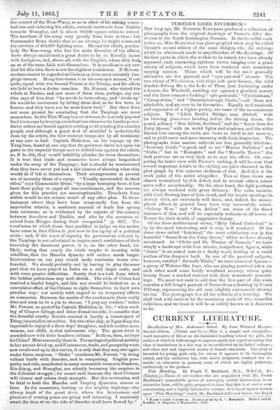TURNER'S LIBER STLIDIORUM.*
NOT long ago, Mr. Thurston Thompson produced a collection of photographs from the original drawings of Turner's Libel- Sta- tlioriem in the South Kensington Museum. In the beautiful weirk before us, Miss Berto!acci has photographed what may be called. Turner's second edition of the same designs, viz., de etchings which he afterwards made in amplification of the drawings. Or the four parts in which the work-is to be issued, two have already appeared, each containing eighteen views, ranging over a great variety of subjects, which have been rendered with somewhat varying success. Those which will be the most generally attractive are the pastoral and " epic-pas:oral" classes. The two views of Wirchelsea, with their soft quiet beauty, the wild desolate Solway Mo-s, the Like of Than, just freshening under a breeze, the Windmill, standing out against a glorified sunset, and the three romantic-looking " epic-pastorals," "Twickenham,". "Composition," and " Dunstanborough Castle,"—all these are admirable, and are sure to be favourites. Equally well rendered, and expressive of a higher poetry, are some of the mountainous. subjects. The "Little Devil's Bridge, near Altdorf," with its blowing pine-trees bending before the driving storm, the grand, solitary" Ben Arthur, Scotland," and the "Scene from the Fairy Queen," with its weird lights and shadows, and the white blasted tree among the rocks, are views to dwell in the mem:xy, and to yield more and more meaning with fresh inspection. The photographs from marine subjects are less generally felicitous. "Inverary Castle" is good, and so are "Marine Dabblers" mid "Calm ;" but in "Ramsgate " and the" Martello Tower" the dark portions are so very dark as to mar the effect. On com- paring the latter view with Turner's etching, it will be seen that several important details in the etching are quite obscured in the photograph by this extreme darkness of tint. And this is the weak point of the series altogether. Two or three views are. almost neutralized by this defect, and in several others, minor parts suffer cons■derably. On the other hand, the light portions are always rendered with great delicacy. The calm sunsets, with their floating bars of thin cloud, and the bright openings ira stormy skies, are extremely well done, and, indeed, the atmos- pheric effects in general have been very successfully seized.. " Solway Moss " and "Ben Arthur" are some of the finest instances of this, and will be especially welcome to all lovers of' Turner for their wealth of suggestive beauty.
Of the three architectural views, "Holy Island Cathedral " is by far the most interesting, and is very well rendered. Of the three views called "historical," the most satisfactory one is the beautiful "Scene from the Fairy Queen," which we have already mentioned. In "Christ and the Woman of Samaria" we have simply a landscape with four minute, insignificant figures, while "Jason" is an armed man in a dusky wood, looking at a small section of the dragon's back. In one of the pastoral subjects,. however, entitled" Juvenile Tricks," we have some real figures— a group of Webster-like boys, who are playing practical jokes on each other amid some lovely woodland scenery, whose quiet beauty forms a marked contrast with their unmstlietic proceed- ings. We must not omit to add that the first part of this work contains a full-length portrait of Turner from a drawing by Count D'Orsay, representing the old man (slightly caricatured) stirring his tea. The photograph has all the softness of a drawing. W e- shall look with interest for the remaining parts of this beautiful collection, and we trust it will be as widely known as it deserves to be.



































 Previous page
Previous page